Spicules - Study guides, Class notes & Summaries
Looking for the best study guides, study notes and summaries about Spicules? On this page you'll find 125 study documents about Spicules.
All 125 results
Sort by

-
CSCC Bio 1114 Exam 3 Questions and Answers Graded A 2024
- Exam (elaborations) • 10 pages • 2024
-
- $14.49
- + learn more
Phylum of Parazoa and etc - Porifera = pore bearing = sponges with no tissues Sessile adults, mostly marine Asymmetrical or Radial symmetry Sponge morphology voacb - spongocel, choanocytes, mesohyl, amoebocytes Spongocel, osculum, ostium - central cavity of the sponge, large opening, pores choanocytes - collared cells; flagellated, line the spongocel and beat in unison and move water towards the top osculum; water goes in through the pores with food that may or may not be good to eat ...
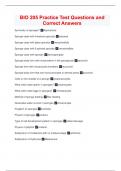
-
BIO 205 Practice Test Questions and Correct Answers
- Exam (elaborations) • 9 pages • 2024
-
Available in package deal
-
- $9.49
- + learn more
Symmetry of sponges? Asymetrical Sponge class with limestone spicules calcarea Sponge class with glass spicules hexactinellida Sponge class with 6 pointed spicules hexactinellida Sponge class with spongin demospongiae Sponge body form with choanoderm in the spongocoel asconoid Sponge form with choanocyte chambers leuconoid Sponge body form that can have porocytes or dermal pores syconoid Cells on the outside of a sponge exopinacocytes What cells make sperm in sponges? choanocytes What ...
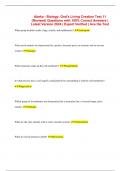
-
Abeka - Biology: God's Living Creation Test 11 (Revised) Questions with 100% Correct Answers | Latest Version 2024 | Expert Verified | Ace the Test
- Exam (elaborations) • 8 pages • 2024
- Available in package deal
-
- $8.49
- + learn more
What group includes snails, slugs, conchs, and nudibrancks? Gastropods What sessile animals are characterized by spicules, incurrent pores, an osculum, and no nervous system? Sponges What molecules make up the cell membrane? Phospholipids In what process does a cell engulf a solid particle by surrounding it with the cell membrane? Phagocytosis Which group of invertebrates are characterized by a muscular foot, a visceral hump, and a mantle? Mollusks What are the only animals with a water-...

-
TAMU BIOLOGY 112 Top Questions and CORRECT Answers
- Exam (elaborations) • 23 pages • 2024
-
- $7.99
- + learn more
Phylum Porifera - No true tissues Asymmetrical symmetry Taxa: -Silicea (glass sponges) -Calcarea (rest of sponges) Osculum - Water exit in sponges Spicules - -Skeletal components of sponges made of silica, calcite or spongin -Produced by amoebocytes Choanocytes - Spong's filter-feeding cells
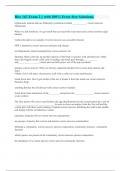
-
Bisc 162 Exam 2 || with 100% Error-free Solutions.
- Exam (elaborations) • 30 pages • 2024
-
Available in package deal
-
- $16.69
- + learn more
triplomastic animals that are bilaterally symmetrical called ___________ . correct answers bilataerians When we add fertilizers, we get runoff that can reach the ocean and cause correct answers algal blooms Carbon dioxide is an example of correct answers an accessible element NPP is limited by correct answers nutrients and climate are Diplomastic animal monophyletic correct answers No Sponges: Many cells line up and the majority of the body is spicules with amoebocytes within them...
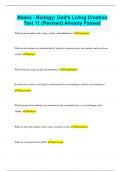
-
Abeka - Biology: God's Living Creation Test 11 (Revised) Already Passed
- Exam (elaborations) • 8 pages • 2024
-
- $7.99
- + learn more
What group includes snails, slugs, conchs, and nudibrancks? Gastropods What sessile animals are characterized by spicules, incurrent pores, an osculum, and no nervous system? Sponges What molecules make up the cell membrane? Phospholipids In what process does a cell engulf a solid particle by surrounding it with the cell membrane? Phagocytosis Which group of invertebrates are characterized by a muscular foot, a visceral hump, and a mantle? Mollusks What are the only animals with a water-...
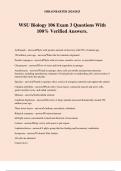
-
WSU Biology 106 Exam 3 Questions With 100% Verified Answers.
- Exam (elaborations) • 14 pages • 2024
- Available in package deal
-
- $10.49
- + learn more
WSU Biology 106 Exam 3 Questions With 100% Verified Answers. Arthropods - answerPhyla with greatest amount of diversity with 85% of animal spp 700 million years ago - answerWhen the first animals originated Porifera (sponges) - answerPhyla with no tissues, muscles, nerves, or specialized organs Choanocytes - answerFlow of water and food acquisition in sponges Amoebocytes - answerFound in sponges, these cells are mobile and perform numerous functions, including reproduction, transport of f...
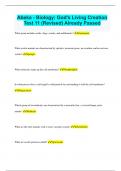
-
Abeka - Biology: God's Living Creation Test 11 (Revised) Already Passed
- Exam (elaborations) • 8 pages • 2024
-
- $8.49
- + learn more
What group includes snails, slugs, conchs, and nudibrancks? Gastropods What sessile animals are characterized by spicules, incurrent pores, an osculum, and no nervous system? Sponges What molecules make up the cell membrane? Phospholipids In what process does a cell engulf a solid particle by surrounding it with the cell membrane? Phagocytosis Which group of invertebrates are characterized by a muscular foot, a visceral hump, and a mantle? Mollusks What are the only animals with a water-...
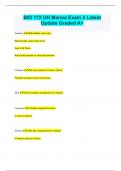
-
BIO 172 UH Manoa Exam 2 Latest Update Graded A+
- Exam (elaborations) • 26 pages • 2024
- Available in package deal
-
- $9.99
- + learn more
BIO 172 UH Manoa Exam 2 Latest Update Graded A+ Animals Multicellular eukaryotes Heterotrophs: Ingest their food Lack Cell Walls Body held together by structural proteins Collagen Make up connective tissues (fibers) Flexible and high tensile (stretching) Skin Dense irregular arrangement of collagen Ligament Collagen arranged in sheets (Connects Bones) Tendon Cable-like arrangement of collagen (Connects muscle to bone) Zygote Fertilized egg (Sperm+Egg=Zygote) Undergoe...

-
BSC1011L Already Passed Exam Questions and CORRECT Answers
- Exam (elaborations) • 15 pages • 2024
-
- $8.49
- + learn more
Phylum Porifera (sponges) multicellular organisms without tissues, organs, or body cavity Heterotroph organism that obtains energy from the foods it consumes; also called a consumer Spicules hard spear or star-shaped structures; made of CaCO3 (limestone) or silica (glass) Choanocyte line the gastrovascular cavity & capture food Amoebocyte digest & distribute food Osculum large opening at the top where excess water leaves Spongocoel large central cavity of the sponge

That summary you just bought made someone very happy. Also get paid weekly? Sell your study resources on Stuvia! Discover all about earning on Stuvia


